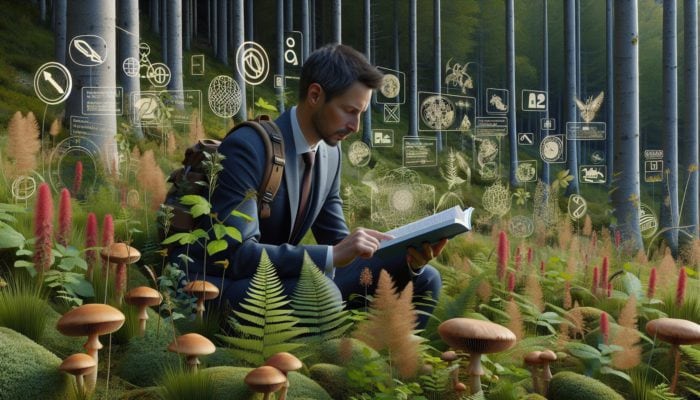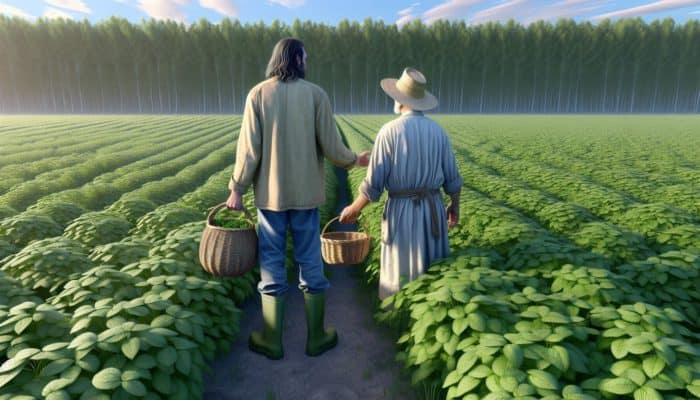Comprehensive Guide to Foraging Safely for Herbs in the UK
Exploring the Rich Variety of Edible Herbs in the UK

Grasping the nuances of herb safety starts with mastering the skill to identify edible herbs prevalent across the diverse landscapes of the UK. This remarkable region boasts an extensive variety of herbs that not only enhance our culinary creations but also offer a wealth of health benefits. A key component of recognising safe herbs involves learning to locate them in their natural habitats. Familiar herbs such as chamomile and mint flourish in a multitude of settings, from well-kept gardens to wild hedgerows. Chamomile is easily identified by its delicate white flowers adorned with vibrant yellow centres, typically flourishing in sun-soaked areas. The invigorating aroma of mint often leads you to it, as its unmistakably refreshing scent can be detected even before the plant comes into view.
Becoming well-acquainted with these herbs is vital for practising safe foraging techniques. For instance, mint prefers moist environments, frequently found near ponds and streams, making it easier to discover when you understand its preferred growing conditions. Moreover, distinguishing among different mint species is critical to avoid any misidentification, as each variety presents unique flavours that can enhance your culinary endeavours significantly.
Identifying key characteristics such as leaf shape, flower colour, and habitat types is essential in differentiating safe herbs from potentially hazardous imposters. Engaging with local herb identification resources or using mobile applications can significantly streamline this educational process, offering clear visual references that make the identification of herbs both enjoyable and accessible.
Evaluating the Safety of Herbs Before You Consume Them
When delving into how to identify safe herbs, assessing their safety is paramount. Not every attractive herb is safe for consumption, and steering clear of potential toxins necessitates a firm grasp of plants specific to the UK known for their culinary or medicinal properties. Investigating local databases or consulting comprehensive herb identification manuals can provide invaluable insights into which herbs are edible and which should be avoided, guiding you through your foraging journey with confidence.
It is equally important to evaluate the environment from which you are foraging. Are there any pollutants or harmful substances that could compromise the integrity of the herbs? Urban foraging, in particular, presents distinct challenges, as the likelihood of contamination from heavy metals and chemicals increases. Always ensure that your foraging locations are free from pesticides and other environmental hazards to safeguard your health.
A practical suggestion for ensuring herb safety is to consult reputable resources, such as the National Institute of Medical Herbalists or local herbalist groups. These organisations provide essential information about local herbs and their associated risks. Engaging with knowledgeable professionals within these communities ensures that your understanding of how to identify safe herbs is comprehensive and reliable.
Leveraging Local Expertise for Accurate Herb Identification
The wealth of knowledge possessed by local herbalists and botanists represents a priceless asset for anyone keen on mastering how to identify safe herbs. These experts can offer insights that go beyond basic identification, including advice on safe usage and potential risks. By joining local herb societies or attending workshops, you can connect with these seasoned professionals, creating opportunities to learn from their extensive experience and expertise.
Furthermore, local experts can direct you to specific areas renowned for particular herbs. For example, if you’re excited to discover wild garlic, they can point you to certain woodlands or meadows where it grows abundantly. Their insights can also shed light on the cultural significance of various herbs within the UK, enriching your appreciation of their historical and medicinal uses.
Consider reaching out to nearby universities or botanical gardens, as many offer public lectures and resources for those eager to expand their knowledge of herbs. Establishing connections with these experts not only enhances your foraging experience but also encourages community involvement and sustainable practices.
Navigating the Legal Landscape of Foraging in the UK

Understanding Foraging Laws and Regulations in the UK
Engaging in foraging for herbs within the UK is subject to a variety of laws that every aspiring herbalist should thoroughly understand. Familiarising yourself with these regulations is crucial to ensure that your foraging activities are both ethical and lawful. While many herbs can be foraged freely, certain areas may impose specific regulations to protect local wildlife and natural habitats.
For example, in England, the Wildlife and Countryside Act of 1981 establishes restrictions on the picking of certain wild plants. It is essential to confirm whether the area you plan to forage in has particular bylaws or restrictions in place. National Parks and Areas of Outstanding Natural Beauty may impose stricter regulations, so it’s prudent to carry a guidebook or consult local authorities before embarking on your foraging adventure.
Respecting these laws is vital not only for environmental conservation but also for promoting sustainable foraging practices. Responsible foragers play an important role in preserving biodiversity, ensuring that future generations can also enjoy the natural resources available today. When in doubt, it is always wise to seek clarification on any legal queries related to foraging.
Identifying Protected Plant Species Under UK Legislation
Understanding which plant species are protected under UK law is essential for anyone interested in identifying safe herbs. Certain plants, such as the delicately pink-tinged Lady’s Slipper orchid, are legally protected and must never be harvested. Collecting these plants not only incurs legal penalties but also jeopardises their survival in the wild.
To avoid unintentionally harming protected species, it is crucial to educate yourself about the plants commonly found in your foraging areas. Numerous resources, including local guides and online databases, provide lists of protected species specific to different regions within the UK. Familiarity with these plants is essential for safeguarding biodiversity and preserving our natural heritage for future generations.
If you encounter an unfamiliar plant while foraging, it’s advisable to take a photograph with your smartphone and consult an identification app or a local expert before proceeding with any harvesting. This precaution helps to ensure you understand the legal implications and promotes responsible foraging practices.
Securing Permission for Foraging on Private Land

Obtaining permission before foraging on private land is a critical aspect of identifying safe herbs legally. While many public lands welcome foragers, private property necessitates explicit consent from the landowner. Neglecting to secure permission can lead to legal repercussions, including potential trespassing charges.
To uncover foraging opportunities, consider reaching out to local farmers or landowner associations. Many landowners appreciate the interest in sustainable practices and may even welcome foragers as a means of managing their land responsibly. Establishing positive relationships can lead to rewarding foraging opportunities while respecting the rights of property owners.
Charming rural communities often hold a wealth of foraging potential. Engaging with these communities can unveil hidden treasures within private properties that might otherwise remain unexplored. Always approach private landowners with respect and transparency regarding your intentions, fostering mutually beneficial relationships.
Identifying Natural Habitats for Foraging Opportunities
Discovering Edible Herbs in Woodland Ecosystems
The woodlands of the UK serve as treasure troves for herb enthusiasts eager to learn how to identify safe herbs. These lush ecosystems boast numerous edible herbs, including nettles and elderflower. Often disregarded as mere nuisances, nettles are surprisingly nutritious and can be incorporated into soups and herbal teas when prepared correctly. The young leaves are particularly sought after for consumption due to their tender texture and high vitamin content.
The delicate white flowers of elderflower become prominent during the early summer months, and being able to recognise this herb is vital, as it can be transformed into delightful syrups and cordials. The key identification feature is its creamy white flowers, which grow in clusters. When gathering elderflowers, ensure you select blooms from trees situated away from busy roads or polluted areas to guarantee their safety.
Identifying woodland habitats necessitates knowledge of tree species, soil types, and the overall ecosystem. Understanding the interplay of these elements can significantly enhance your ability to locate herbs. Participating in guided foraging walks can further develop your skills, as experienced foragers share valuable insights about the species they encounter while recounting their uses in traditional herbal medicine.
Coastal Foraging: Uncovering Unique Herbal Treasures
The unique coastal environments of the UK are home to a diverse range of herbs that thrive in saline conditions. Learning how to identify safe herbs along the coastline opens exciting new avenues for culinary exploration. A notable example is sea kale, characterised by its broad green leaves and white flowers, which add a distinctive flavour to salads and seafood dishes.
Coastal foraging requires a solid understanding of tidal patterns and the ways in which vegetation responds to salt and wind effects. For example, sea purslane and samphire are other coastal herbs that flourish in similar conditions, offering unique flavours and numerous health benefits. Familiarising yourself with these plants can elevate your foraging efforts, providing nutritious options that are often overlooked.
Safety should always be a primary concern. Ensure that the areas you forage in are free from pollution, particularly in heavily trafficked coastal regions. Coastal herbs, while delicious, can absorb contaminants from their surroundings, making responsible foraging practices essential.
Urban Foraging: Discovering Herbal Treasures in City Landscapes
Urban environments often abound with herbal treasures, as many herbs thrive in unexpected locations. Identifying safe herbs in these areas requires keen observation of your surroundings. Dandelions, for instance, are frequently found in parks and gardens, with their leaves suitable for salads and flowers perfect for making wine.
Another urban favourite is the frequently overlooked chickweed, a delicate herb found in gardens and neglected spaces. Chickweed is edible and boasts a subtle flavour that complements a variety of dishes. Identifying urban herbs necessitates a discerning eye and an understanding of their specific growing conditions.
Exploring urban foraging is not merely about finding herbs; it also involves connecting with local ecosystems. Various community groups organise foraging walks where you can learn from experienced foragers while fostering a sense of community. These experiences not only enhance your knowledge but also encourage a deeper appreciation for the urban environment.
Meadow Foraging: Unveiling a Diverse Array of Herbs
Meadows across the UK offer a vibrant assortment of herbs for those eager to learn how to identify safe herbs. Wild thyme, for instance, is a fragrant herb often found in grassy meadows. Its small purple flowers and creeping growth habit make it a delightful addition to any garden or culinary dish.
Another noteworthy meadow herb is the oxeye daisy, which is not only visually striking but also edible. Its petals can add a splash of colour to salads and are rich in vitamins. Familiarising yourself with these herbs requires an understanding of their growing conditions, which often include sunny, well-drained soils.
Engaging in meadow foraging can also be a sensory delight, as the sights, sounds, and smells of the environment enhance the overall experience. Joining local conservation groups can provide opportunities for guided meadow walks, where you can learn about herb identification while contributing to habitat preservation. The combination of practical knowledge and community involvement makes meadow foraging a rewarding pursuit.
Seasonal Availability of Herbs in the UK
Spring Awakening: Spotting Early Season Herbs
Spring heralds the arrival of many delightful herbs in the UK, making it an ideal time to explore how to identify safe herbs. One of the first to emerge is wild garlic, identifiable by its distinctive broad leaves and robust garlic aroma. Commonly found in woodlands, wild garlic can be recognised by its star-shaped white flowers that bloom in spring, serving as a fantastic addition to pesto or soups.
Another spring favourite is the young leaves of nettles, which are nutrient-rich when harvested early. These tender shoots can be transformed into soups or brewed into herbal teas. Learning to identify these plants early in the season ensures that you can fully enjoy their flavours and health benefits.
Spring also presents an excellent opportunity to engage with local foraging groups. These communities often organise seasonal foraging walks, providing guidance on identifying and harvesting early herbs. Participating in these activities not only enhances your foraging skills but also allows you to connect with like-minded individuals passionate about wild food.
Summer Bounty: Exploring the Abundance of Herbs
The summer months burst forth with a multitude of herbs ripe for discovery in the UK. Among these, St. John’s wort stands out with its bright yellow flowers and distinctive leaves. This herb is renowned for its potential antidepressant properties and is commonly found in sunny meadows. Accurate identification is crucial; observe for its unique black spots on the leaves which help differentiate it from other plants.
Another versatile summer herb is borage, known for its star-shaped blue flowers and cucumber-like flavour. Borage is easily spotted in gardens and is frequently incorporated into refreshing drinks and salads. Understanding the seasonal growth patterns of these herbs enhances your ability to identify them in their natural habitats.
Participating in summer foraging workshops can help solidify your knowledge and provide practical experience. Many communities offer classes focusing on summer herbs, greatly boosting your confidence in identifying and harvesting these valuable plants. Embrace the richness of summer herbs and seize the opportunity to experiment with their culinary applications.
Autumn and Winter Foraging: Embracing Seasonal Herbs
As the seasons shift, the availability of herbs also changes, presenting unique opportunities for those eager to learn how to identify safe herbs. Autumn brings a bounty of rosehips, the vibrant red fruits of the wild rose. Rich in vitamin C, these can be used in delicious syrups and jams. Identifying them is straightforward; they are typically found in hedgerows and can be harvested from late summer through autumn.
Winter foraging may yield fewer options; however, there are still safe herbs to be found. The resilient sage, commonly found in gardens, can be harvested throughout the winter months. Its robust flavour adds warmth to hearty dishes, making it a staple herb for the colder seasons.
To maximise your foraging success during these chillier months, consider joining local foraging groups that host winter walks. These excursions are invaluable for connecting with fellow enthusiasts while learning about the specific herbs that thrive in winter conditions.
Safe and Effective Techniques for Harvesting Herbs
Essential Tools for Successful Herb Foraging
Equipping yourself with the appropriate tools is essential for effective and safe harvesting of herbs in the UK. When learning how to identify safe herbs, consider investing in high-quality harvesting shears or scissors that can cleanly cut herbs without damaging the plant. This practice promotes regrowth and ensures the sustainability of the herb population.
A sturdy basket is another critical tool for herb foraging. It facilitates the safe transport of harvested herbs while ensuring adequate airflow to prevent wilting. Always carry a field guide or foraging app to assist in identification while out in the field. A small notebook can also prove beneficial for jotting down notes about your foraging experiences or any plants you encounter that you wish to learn more about in the future.
Before heading out, make sure you’re dressed suitably for the weather and terrain. Sturdy footwear and protective clothing can prevent injuries and discomfort during your foraging adventures. Having the right tools enhances your experience and instills a sense of professionalism in your foraging efforts.
Implementing Responsible Harvesting Practices
Practising ethical harvesting is fundamental when exploring how to identify safe herbs in the UK. Always adhere to the principle of taking only what you need, ensuring that plants can continue to flourish in their natural habitats. For annual herbs, only harvest a small percentage of the plant to allow for regeneration.
Moreover, it is vital to be conscious of the surrounding ecosystem. Avoid trampling on other plants or disturbing wildlife habitats while foraging. Responsible foraging practices support biodiversity and promote the health of local ecosystems. Collaborating with local conservation groups can provide guidance and best practices for ethical harvesting.
Consider adopting a “leave no trace” philosophy. This entails leaving the area as you found it, minimising your impact while enjoying nature. By practising responsible harvesting, you contribute positively to the environment and ensure that future generations can also enjoy an abundance of wild herbs.
Methods for Storing and Preserving Your Foraged Herbs
After successfully harvesting herbs, knowing how to store and preserve them properly is vital. Proper storage methods maintain the potency and flavour of your herbs, ensuring you can enjoy them long after your foraging adventure. Air-drying is an effective technique for many herbs; hang them upside down in a dark and dry space to allow air to circulate freely around the leaves.
Another preservation method involves freezing. For herbs such as basil or parsley, you can chop them and place them in ice cube trays filled with water or oil. This technique allows for convenient use in future recipes, ensuring you have access to the flavours of your foraged herbs throughout the year.
It is also essential to label your stored herbs, including the date of harvesting. This practice helps you track freshness and maintain organisation in your pantry. Understanding these preservation techniques not only maximises your foraging efforts but also ensures you can relish the benefits of safe herbs across the seasons.
Complying with Foraging Regulations and Guidelines
Remaining compliant with foraging regulations is a crucial aspect of identifying safe herbs and harvesting them legally in the UK. Familiarise yourself with local laws regarding foraging and harvesting practices, as each region may impose specific regulations governing the collection of wild herbs. Consulting local authorities or community groups can provide clarity on these matters.
When harvesting in protected areas, it is vital to adhere strictly to the guidelines established by conservation organisations. Some locations may limit the number of plants you can collect or may entirely prohibit foraging to safeguard native species. Understanding these regulations fosters a culture of responsible foraging and contributes to long-term ecological health.
By staying informed and compliant, you not only protect yourself but also promote sustainable practices within the foraging community. Share your knowledge with fellow foragers and encourage them to educate themselves about local laws, fostering a collective responsibility towards preserving our natural resources.
Avoiding Misidentifications: Ensuring Safe Herb Foraging
Identifying Lookalike Herbs to Prevent Dangerous Mistakes
When exploring how to identify safe herbs, awareness of lookalike herbs is critical. Many harmless herbs have toxic counterparts that can be easily confused with them. For example, the benign wild carrot is often mistaken for the toxic hemlock. Learning to identify distinctive features, such as leaf shape and flower structure, is essential in preventing dangerous misidentifications.
Familiarising yourself with these lookalikes requires diligent observation. Closely study the plant and its surroundings to notice subtle differences in appearance and growth habits. Using field guides or identification apps can provide visual cues that assist in distinguishing safe herbs from their toxic counterparts.
Joining local foraging groups can also enhance your understanding of lookalikes. Experienced foragers can share their insights and guide you through the identification process, ensuring your safety. By learning from others, you can build confidence and a solid knowledge base, empowering you to forage responsibly.
Recognising Poisonous Variants to Mitigate Risks
Danger lurks in misidentifying herbs, particularly with poisonous variants. Understanding the characteristics of these harmful herbs is essential when learning how to identify safe herbs. For instance, the toxic yew tree produces berries that can easily be mistaken for edible fruits. Its needle-like, dark green leaves serve as clear identification markers to help you avoid accidental ingestion.
Being aware of poisonous variants should be a priority for any forager. Research local flora and learn to recognise which harmful plants may be present in your foraging areas. This knowledge is vital for safe harvesting, enabling you to distinguish between safe and unsafe herbs accurately.
Additionally, consider documenting any plants you encounter that you are uncertain about. Taking photographs and referring to reputable resources for guidance can reinforce your learning. Building a library of local plants helps you gain confidence in identifying safe herbs.
Conducting Thorough Safety Checks While Foraging
Performing thorough safety checks is paramount when foraging. Engaging in how to identify safe herbs involves verifying the identity of any plant before consumption. Use multiple resources to cross-check your findings; never rely solely on a single source or image for identification.
When in doubt, consult local experts or community groups. Their experience can provide valuable insights and help confirm your identifications. Engaging with local foraging communities fosters a spirit of shared knowledge, enhancing everyone's understanding of safe wild herbs.
Maintaining an inquisitive mindset is essential. Always ask questions and seek clarification when uncertain about a specific herb. Keeping open lines of communication with experienced foragers not only enriches your knowledge but also strengthens the entire foraging community.
Understanding Regional Variations in Herb Identification
Herb identification can vary significantly across different regions in the UK. Understanding these regional differences is crucial when learning how to identify safe herbs. Certain herbs may thrive in specific climates or soil types, which can impact their appearance and growth patterns. For instance, coastal regions may host herbs like sea beet that flourish in saline conditions, while inland areas may support distinct wildflower varieties.
To navigate these regional variations effectively, consider collaborating with local foragers or attending regional herb workshops. These interactions provide invaluable insights into the unique herbs found in specific areas, promoting a deeper understanding of regional flora.
Keeping a detailed journal of your foraging experiences can also be beneficial. Documenting the herbs you find, their habitats, and any notable characteristics helps track your progress and reinforces your learning. Over time, this practice will allow you to navigate regional differences with confidence, ensuring safe and successful foraging adventures.
Essential Resources for Herb Enthusiasts in the UK
Recommended Books and Guides for Successful Foraging
Utilising UK-specific books and guides is crucial for anyone keen on identifying safe herbs. Numerous publications delve into the complexities of local flora, providing valuable insights into identification, uses, and safety considerations. Seek out books authored by reputable herbalists or botanists with extensive knowledge of UK plants.
Field guides are particularly valuable, as they often include photographs, descriptions, and details about habitat preferences. Investing in these resources enhances your ability to identify herbs confidently while foraging. Many guides also cover the culinary and medicinal uses of herbs, enriching your overall foraging experience.
In addition to printed materials, consider utilising digital resources such as apps that focus on UK flora. These can serve as handy companions during your foraging adventures, offering instant access to identification tools and community forums where you can ask questions and share experiences with fellow foragers.
Connecting with Online Forums and Community Networks
Joining online forums and groups dedicated to herb enthusiasts in the UK can greatly enhance your understanding of how to identify safe herbs. Platforms such as social media or dedicated websites provide spaces for individuals to share their experiences, pose questions, and connect with like-minded foragers.
Participating in these communities fosters a collaborative spirit, with members often sharing tips, advice, and even photographs of their foraging finds. Engaging in discussions about specific herbs can deepen your understanding and introduce you to new foraging opportunities you may not have previously considered.
Consider participating in online challenges or events, where members can showcase their foraging experiences and share their findings. These interactions can inspire your foraging journeys while building connections that enrich your understanding of local flora.
Enrolling in Workshops and Courses for In-Depth Learning
Enrolling in workshops and courses focused on herb identification can significantly boost your confidence in identifying safe herbs. Many local educational institutions and community centres offer classes that delve into various aspects of foraging, including plant identification, harvesting techniques, and culinary applications.
These hands-on experiences provide valuable opportunities to learn directly from experienced herbalists and foragers. Practical demonstrations foster engagement, ensuring that you can apply your newfound knowledge immediately in real-world scenarios.
Many workshops also cover local regulations and ethical foraging practices, ensuring you’re well-prepared to forage responsibly. Building connections with fellow participants can further enhance your learning experience, creating a supportive community of herb enthusiasts eager to share their knowledge and experiences.
Joining Local Herb Societies for Collaborative Learning Opportunities
Becoming a member of local herb societies is an excellent way to expand your knowledge and skills in identifying safe herbs. These societies often organise events, workshops, and foraging walks, providing valuable opportunities for hands-on learning and community engagement.
Participating in society activities allows you to connect with fellow herb enthusiasts, share experiences, and gain insights from seasoned foragers. Many societies also offer newsletters or publications focused on local herbs, keeping you informed about new findings and developments in the world of foraging.
Consider attending society meetings, where you can engage in discussions about various herbs, their uses, and identification techniques. This community-driven approach not only enhances your foraging experience but also fosters a sense of responsibility towards preserving local ecosystems.
Addressing Frequently Asked Questions About Foraging
What are some common herbs found across the UK?
Common herbs found in the UK include chamomile, mint, wild garlic, and nettles. These herbs are not only safe for consumption but are also widely valued for their culinary and medicinal properties.
How can I determine if a herb is safe to eat?
To ascertain if a herb is safe, consult reputable identification resources, observe its key characteristics, and verify this information against multiple sources. Always err on the side of caution and consult local experts if you are uncertain.
Are there legal restrictions regarding foraging in the UK?
Yes, foraging laws in the UK can vary by region. It is essential to check local regulations, particularly in protected areas, to ensure responsible and lawful foraging practices.
What should I do if I suspect I’ve consumed a toxic herb?
If you suspect poisoning from a toxic herb, seek immediate medical attention. Bring any remaining herbs or photographs for identification to assist medical professionals in providing the appropriate care.
Can I forage herbs in urban settings?
Indeed, urban foraging is possible and can be quite rewarding. However, ensure that you are aware of any pollutants or pesticides that may affect the safety of herbs harvested in urban areas.
How should I store freshly harvested herbs?
Freshly harvested herbs can be stored by air-drying, freezing, or keeping them in a cool, dark environment. Ensure you label them for easy identification later.
What are common lookalike herbs to be cautious of?
Common lookalikes include wild carrot (which resembles toxic hemlock) and elderflower (which may be confused with poisonous members of the same family). Always double-check identifications before consuming.
How can I join local foraging groups?
You can join local foraging groups by searching online platforms, community bulletin boards, or social media. Many communities have dedicated groups focused on foraging and herb identification.
What constitutes ethical foraging?
Ethical foraging involves taking only what is necessary, ensuring that plants can regenerate, and respecting local laws and ecosystems. It promotes sustainability and the health of natural habitats.
Where can I find reliable resources for identifying herbs?
Reliable herb identification resources include field guides, local herb societies, and online apps focused on UK flora. Consult reputable sources for accurate and detailed information.
Connect with us on Facebook!
The Article: How to Identify Safe Herbs: A UK Guide appeared first on https://mcrtherapies.co.uk
The Article Safe Herbs: A UK Guide to Identification and Use Was Found On https://limitsofstrategy.com


I really enjoyed reading about the different edible herbs found in the UK! It’s fascinating how much flavor and health benefits are packed into these little plants. I’ve dabbled in foraging a bit, and I find it such a rewarding experience – like a scavenger hunt for nature’s hidden treasures.